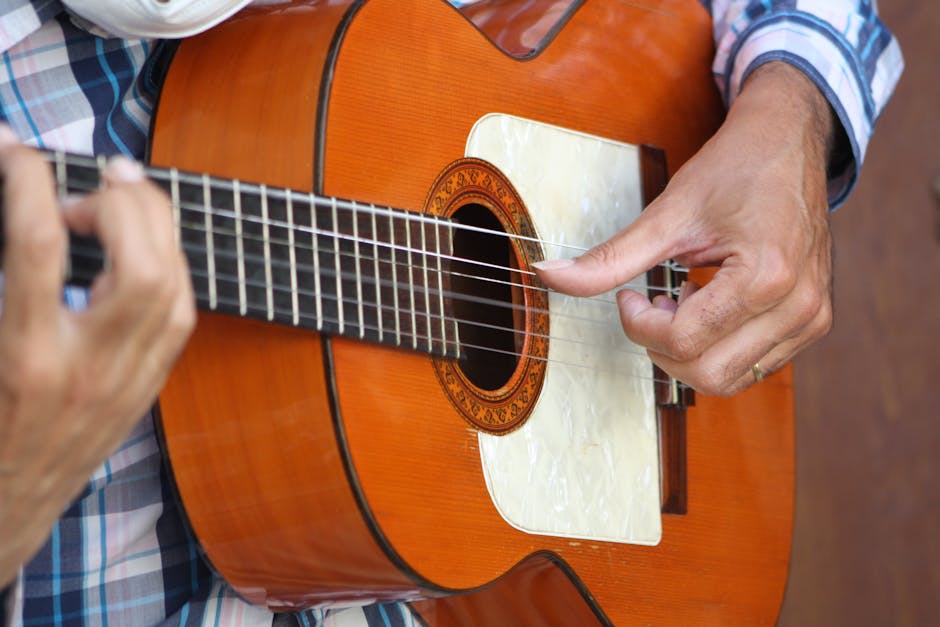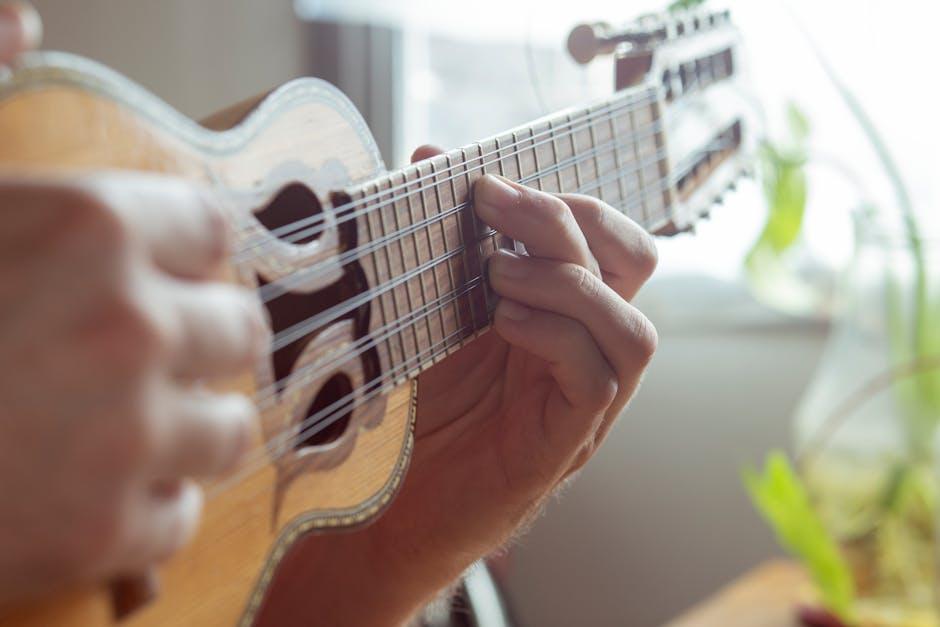Are you tired of feeling like your fingers are tangled in a spider’s web every time you try to nail that intricate fingerpicking pattern on your acoustic guitar? Well, fear not, dear guitarists, for we have the keys to unlocking those complex fingerpicking techniques that will have you plucking and strumming like a pro in no time. So grab your guitar, put on your fingerpicking gloves, and get ready to master the art of complexity with a dash of humor and a pinch of skill. Let’s dive in and untangle those musical webs together!
Contents
- 1 Understanding the Basics of Fingerpicking on Acoustic Guitar
- 2 Exploring Different Fingerpicking Patterns for Enhanced Musical Expression
- 3 The Role of the Thumb in Achieving Bass Line Precision and Stability
- 4 Incorporating Melodic Lines within Fingerpicking Patterns for Textural Richness
- 5 Mastering the Integration of Percussive Elements into Your Fingerpicking Style
- 6 Adapting to Various Musical Genres Through Advanced Fingerpicking Techniques
- 7 Overcoming Common Challenges and Mistakes in Complex Fingerpicking
- 8 FAQs
- 9 Strumming Towards Success!
Understanding the Basics of Fingerpicking on Acoustic Guitar
So you’ve decided to tackle the mesmerizing world of fingerpicking on your acoustic guitar. Congratulations! You’re about to embark on a journey that will not only impress your friends and family, but will also bring you endless hours of joy. But before you can become the next guitar virtuoso, you need to understand the basics of fingerpicking.
First things first, let’s talk about finger placement. Your thumb should be designated to handle the bass notes, while your index, middle, and ring fingers will take care of the melody and harmonies. It’s like assigning different roles to different members of a dysfunctional family. Embrace the chaos and make beautiful music.
Next, let’s discuss fingerpicking patterns. There are countless patterns out there, but some popular ones include the Travis Picking pattern and the Clawhammer technique. Experiment with different patterns to find what works best for you. Remember, there’s no right or wrong way to fingerpick, as long as you’re having fun and creating sweet music.
Lastly, practice, practice, practice! Fingerpicking is like a muscle that needs to be continuously exercised. Start slow and gradually increase your speed. Don’t get discouraged if your fingers feel like they have a mind of their own at first – they’ll eventually fall into line. Just keep at it and soon enough, you’ll be fingerpicking like a pro.

Exploring Different Fingerpicking Patterns for Enhanced Musical Expression
So, you’ve mastered the basic fingerpicking patterns and want to level up your musical expression, huh? Well, you’ve come to the right place! Let’s dive into some fingerpicking patterns that will make your guitar sing like never before.
First up, we have the Travis Picking pattern. Named after Merle Travis, this pattern involves alternating the bass notes with your thumb while picking the melody with your other fingers. It’s like patting your head and rubbing your belly at the same time - challenging but oh so satisfying once you get the hang of it.
Next, let’s talk about the Arpeggio pattern. This fancy word simply means breaking up a chord into individual notes and playing them in a sequence. It’s like plucking the strings of a harp, creating a cascading sound that will make your listeners swoon with delight.
And last but not least, we have the Roll pattern. This involves rolling your fingers across the strings in a smooth and continuous motion, creating a seamless and flowing sound. It’s like a gentle breeze on a summer day, soothing and refreshing to the ears.

The Role of the Thumb in Achieving Bass Line Precision and Stability
When it comes to playing bass lines, the thumb is the unsung hero. This little appendage may seem insignificant, but it plays a crucial role in achieving precision and stability in your bass playing. Here’s how:
First off, your thumb provides the anchor that keeps your bass line steady. Just like a ship needs an anchor to stay in place, your bass line needs the thumb to stay grounded and on beat. Without this stable foundation, your bass line would drift aimlessly like a boat without a crew.
Secondly, the thumb is the muscle behind all those killer bass riffs. It gives you the power and control needed to navigate the fretboard with precision and finesse. Whether you’re slapping, popping, or plucking, your thumb is the driving force behind every note you play.
So next time you’re jamming out on the bass, take a moment to appreciate the humble thumb. It may be small, but it’s mighty when it comes to achieving bass line precision and stability. Rock on, thumb warriors!

Incorporating Melodic Lines within Fingerpicking Patterns for Textural Richness
When it comes to fingerpicking, adding melodic lines can bring your playing to a whole new level of awesomeness. Imagine blending the intricate intricacies of fingerpicking patterns with the sweet melodies of your favorite tunes. It’s like peanut butter and jelly, but for your guitar playing!
One way to incorporate melodic lines within fingerpicking patterns is to identify the key of the song you’re playing and experiment with different scales that fit within that key. This will help you create melodic lines that complement the chords you’re playing and add a layer of richness to your sound. Think of it as adding a splash of color to a black and white painting.
Another tip is to use hammer-ons and pull-offs to create smooth melodic transitions within your fingerpicking patterns. Instead of just plucking each note individually, try connecting them with these techniques to give your playing a more fluid and expressive feel. It’s like adding a fancy swirl to your latte – it just makes it that much more delicious!
Don’t be afraid to experiment and get creative with incorporating melodic lines within your fingerpicking patterns. Mix and match different scales, try out new techniques, and above all, have fun with it! Before you know it, you’ll be wowing your friends and family with your newfound textural richness and musical prowess.

Mastering the Integration of Percussive Elements into Your Fingerpicking Style
So you want to add some percussive flair to your fingerpicking style, eh? Well, you’ve come to the right place! Integrating percussive elements into your fingerpicking can take your playing to a whole new level, adding rhythm and groove in ways you never thought possible.
First things first, you’ll need to master the art of tapping. Start by practicing tapping your fingers on the body of your guitar in time with your picking. Keep a steady rhythm and experiment with different patterns and accents to really make your playing pop.
Next, try incorporating slap techniques into your fingerpicking. Slap the strings with the side of your thumb or fingers to create percussive sounds that add depth and texture to your playing. Mix it up with different intensities and placements to keep things interesting.
And finally, don’t forget to experiment with incorporating other percussive elements like knocking on the body of your guitar, using a percussion pedal, or even adding in vocal percussive sounds. The more creative you get, the more unique and dynamic your fingerpicking style will become. So go forth and unleash your inner percussive fingerpicking master!
Adapting to Various Musical Genres Through Advanced Fingerpicking Techniques
So you think you’re a fingerpicking pro, huh? Well, get ready to take your skills to the next level and adapt to various musical genres like a boss. With advanced fingerpicking techniques, you’ll be able to tackle everything from blues to bluegrass with ease.
First up, let’s talk about alternating bass notes. This technique involves using your thumb to switch between two bass notes, creating a funky and rhythmic sound that’s perfect for country and folk music. Practice keeping a steady beat while alternating between bass notes to master this technique.
Next, let’s explore the world of syncopation. This fancy term simply means playing off the beat, adding an unexpected twist to your fingerpicking patterns. Experiment with playing notes on the “and” of each beat to create a funky groove that’s sure to impress.
And finally, don’t forget about fingerpicking patterns. By mastering different patterns such as arpeggios, rolls, and tremolos, you’ll be able to adapt to a wide range of musical styles. Get creative with your patterns and experiment with different combinations to find your own unique sound.
Overcoming Common Challenges and Mistakes in Complex Fingerpicking
When it comes to complex fingerpicking, there are a few common challenges and mistakes that players often encounter. But fear not, dear fingerpickers! With a bit of practice and some helpful tips, you can overcome these obstacles and master the art of intricate fingerstyle guitar playing.
One of the most common challenges in complex fingerpicking is maintaining proper hand position. It’s easy to get caught up in the flurry of notes and lose track of where your fingers are supposed to be. Remember to keep your hand relaxed and your fingers curved for optimal dexterity. And don’t forget to pay attention to your thumb placement – it plays a crucial role in creating a solid foundation for your picking hand.
Another common mistake that fingerpickers make is rushing through difficult passages. Slow down, take a deep breath, and focus on playing each note cleanly and accurately. Remember, speed will come with time and practice. Don’t sacrifice precision for tempo – your fingers will thank you in the long run!
Lastly, don’t be afraid to experiment with different fingerpicking patterns and techniques. It’s easy to fall into a rut and stick with what feels comfortable, but branching out and trying new things can lead to exciting musical discoveries. Embrace the challenge, be patient with yourself, and most importantly, have fun with your fingerpicking journey!
FAQs
What are some common mistakes beginners make when learning complex fingerpicking techniques?
Common mistakes include using the wrong fingers for picking, not maintaining proper hand positioning, and rushing through the exercises without focusing on precision.
How can I improve my fingerpicking speed and accuracy?
To improve speed and accuracy, practice slowly and gradually increase your tempo. Focus on each individual finger and make sure your movements are efficient and controlled.
What are some exercises I can do to build finger strength for complex fingerpicking?
Some exercises to build finger strength include practicing scales, arpeggios, and fingerpicking patterns with a metronome. You can also try using fingerpicking-specific exercises like Travis picking or clawhammer techniques.
How important is it to incorporate dynamics into my fingerpicking technique?
Dynamic control is crucial in fingerpicking, as it adds expressiveness and emotion to your playing. Practice playing softly and loudly to master different levels of dynamics.
Should I use fingerpicks or play with my bare fingers for complex fingerpicking?
Whether you use fingerpicks or play with bare fingers is a matter of personal preference. Experiment with both and see which feels more comfortable and allows you to achieve the sound you want.
Strumming Towards Success!
Congratulations on diving into the world of complex fingerpicking techniques for acoustic guitar! With practice, patience, and a touch of humor, you’ll soon be strumming your way to success. So keep those fingers nimble, those strings plucked, and remember – even the greatest guitarists started out as beginners. Rock on!



